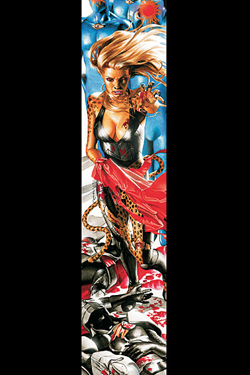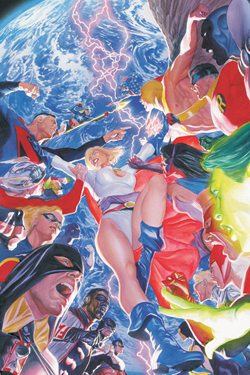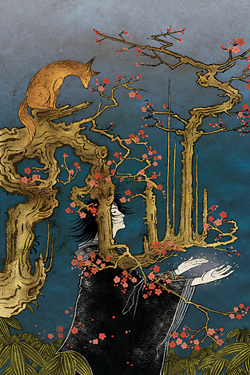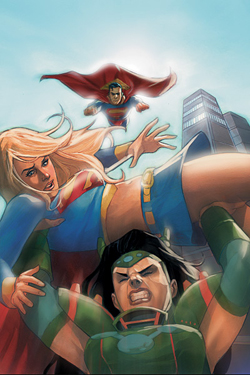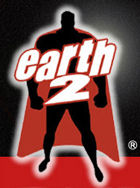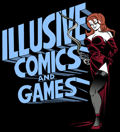|
From
Box Four 11/11/08
brought to you by Illusive
Comics and Games of Santa Clara
Final Crisis: Resist
Accepting that there's just no such thing as an event book
that actually can get its entire story told in its own pages,
Resist proves to be pretty good. Now, if you are
instead incredibly ticked that you have to buy more than
just Grant Morrison's Final Crisis and even that's
not only delayed but it won't even be one artist finishing
it, well, you're still probably going to want to buy this
book.
Far better than the Revelations
mini-series, Resist covers the last shreds of Checkmate
making a final stand against the forces of Darkseid. Almost
all the superheroes have been overtaken by the Anti-Life
Equation - evil math in the form of unstylish helmets.
In the Arctic, a handful of characters
including Mr. Terrific huddle together for warmth and try
to figure out how to outwit the Lords of Apokolips. Along
the way, Rucka plays fast and loose with characters' continuities,
but not with the characters themselves. As a member of Checkmate,
Mr. Terrific stands out as a leader in a way he doesn't
quite get to do with the Justice Society.
Former JLA mascot Snapper Carr gets a lot
of focus, a nice nod to the Silver Age and one of those
continuity things - the guy has gained powers, had his hands
cut off, regenerated them, shepherded the Hourman android
from the future and…just maybe it was at that last phase
that he gained the powers of teleportation. It seems to
me that for a while when he snapped his fingers he made
things go boom.
Now his heart goes boom when he encounters
the Cheetah, who has a catlike libido in the face of doom.
Actually, that's not fair to cats.
It's a taut issue, and the plan that Mr.
Terrific and company put into motion makes you believe that
yes, all this continuity chaos might really have been planned
several years ago. But then, with Rucka and by extension
Grant Morrison, patience is almost always rewarded in exactly
this fashion.
Justice Society of America #20:
Though only vaguely part of the Final Crisis situation,
this issue does its best to explain the current DC multiverse
in a way that all the other books have either shied away
from or ignored. A piece of it might tie in to the Legion
of 3 Worlds book that Geoff Johns also has on his plate.
The action temporarily sidesteps the Gog
and Magog question, to finally focus on Earth-2. In a lot
of ways, it's just the way Earth-2 was before the first
Crisis. In fact, it's too much like it, to
the point that they already have a Power Girl of their own,
much to our Power Girl's dismay.
Johns and his artistic co-creators give
us a doorway to a potentially fun world that should please
old-timers. But he also gives it an underpinning of melancholy,
as we see characters grapple with counterparts and relatives
in different fates. Though old JLA/JSA crossover stories
would occasionally deal with this issue, here Johns really
makes the pain palpable without going overboard.
It's nice to see the JSA I grew up reading
in the All-Star revival and Adventure dollar
comics. The versions created to fill the void after Earth-2
was banned always seemed a bit hollow in comparison.
It's also nice to see Johns finally address
Mr. Terrific's beliefs (or lack thereof) in a more direct
reasonable fashion, giving the team a glimpse of a Michael
Holt whose life took a very divergent path from that of
superhero.
Though
even Superman himself comments on the absurdity of teams
meeting, misunderstanding and beating the snot out of each
other, the story feels fresh and the continuity may prove
fairly important. This is one of those books that everybody
who likes superheroes should be reading. Plus, there's that
great straightening out of the multiverses…until five years
from now.
The
Sandman: The Dream Hunters #1:
Never having read the original illustrated story (I know,
I know, sacrilege, this book comes as a surprise and a bit
of a revelation. P. Craig Russell's art pops beautifully
off of the page, and his adapting skills are every bit as
impressive as Neil Gaiman says they are in his own little
afterword.
Russell plays with shadow and light in
a way few other artists can capture. Thus he captures mood
with a rare flexibility, and he can dance from grotesque
to classically beautiful in one panel. Of course, this fits
Gaiman's work perfectly.
The character of Morpheus makes one of
his hidden appearances, in a story hinting at reality being
greater than mankind can imagine. Or rather, what mankind
imagines actually is, and we're pretty small in it.
Fashioned as a Japanese folk story - sprung,
as Gaiman has apparently had to defend for years, out of
the author's own head and not out of an earlier source --
The Dream Hunters feels classical and post-modern
at the same time. Gaiman completists will want it, of course.
Though it may not be the best introduction to The Sandman,
it's still a wonderful piece that might be fun for kids,
too.
Secret Six #3:
Forget the Joker. Forget Darkseid. Gail Simone's mind has
birthed the absolutely most terrifying villain in the DC
Universe - the creature called Junior. I suspect he might
be somehow related to the Six's Ragdoll, but that's only
because I want there to be some connection that the team
can exploit against him…or it.
Otherwise, they're toast.
If you're not reading Secret Six,
you're missing out. Each mini-series has been a great story,
with growing characterization and a believable turn of Catman
as one of the baddest asses in the DCU, and yet we still
don't know the whole story. What I just noticed this month
is that finally this is an ongoing series. Welcome news,
because Simone has created her masterpiece with this team.
And after her incredible run with Nicola Scott on Birds
of Prey, that's saying something.
With this issue, conspiracies come to light,
and the Macguffin is literally one hell of a great idea,
even as it's just a little bit silly. This is delirious
fun dealing with supervillains, some unrepentant and some
trying to wrestle with the question of just where they stand
on that whole good/bad thing.
Scott's artwork here continues to be outstanding,
and though for some reason she hasn't broken out as being
a huge fan favorite yet, she should. Her pencils are always
solid, and she actually lets them serve the story, instead
of stopping to be flashy and…ah…that's why she's not a fan
favorite. She actually tells the story instead of draws
poster images.
Keep going, Six. Glad to have you back
for the long haul.
Superman/Supergirl: Maelstrom #1
And so I end with a sort of flipside to Final Crisis:
Resist. This book relies entirely on what Grant Morrison
called "consistent characterization," meaning it doesn't
matter where it fits; what matters is that the characters
behave with the traits you have come to expect.
Of course, with the new Supergirl, it's
hard to know. Apparently she will be stuck for some time
in the Kyle Rayner zone of always being just on the verge
of being a super-competent superhero, if only she'd believe
in herself more.
If DC is right and that Supergirl is a
role model, or at least a character teen girls can identify
with, I suppose that's not a bad place to be. They might
be a little turned off, however, by the constant paternalism
of her older cousin, Superman. As a regular reader of Superbooks,
I might not be as cranky about this if it hadn't been played
every single time I see Supergirl in a book other than her
own. Oh, and her own.
While Final Crisis has a completely
revamped Fourth World, this book utilizes the classic Jack
Kirby vision of the characters. One of Granny Goodness'
pupils, Maelstrom, dreams of becoming the Bride of Darkseid,
and determines to do the one thing no one has ever managed
to do to please Darkseid. No, not that. She's going to kill
Superman.
It's a reasonably exciting story by Jimmy
Palmiotti and Justin Gray, even though it has no effect
on larger continuity. Every now and then, that's a good
thing. What caught my attention was the art by Phil Noto,
an incredible penciler who somehow manages to invest sixties
commercial art with a modern sensibility. He couldn't have
existed in the Silver Age, but somehow his work evokes it
as being a lot slicker than it actually was.
Let's also applaud the movement to portray
both Kryptonians as actually fairly average-physiqued. A
hypermuscled Superman doesn't make sense. When Noto draws
him, he looks like the All-American Dad in blue tights and
a twinkle in his eye. It's a nice take.
I'm going to give this book another try,
though it's more for Noto's art than a sense of storytelling
urgency.
|
